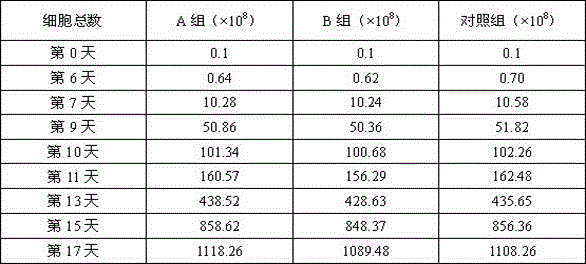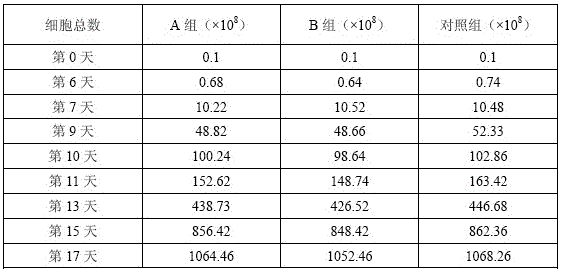Storage method of immune cells and cell freezing medium
A storage method and technology of immune cells, applied in the field of cell preservation, can solve the problems of mismatch between immune cell samples and data information, easy loss of sample data information, increasing the risk of infectious diseases, etc., so as to maintain physiological functions and biological characteristics, The storage method is simple and effective, and the effect of protecting the freezing damage
- Summary
- Abstract
- Description
- Claims
- Application Information
AI Technical Summary
Problems solved by technology
Method used
Image
Examples
Embodiment 1
[0053] Blood is collected from the peripheral blood of healthy subjects, and the preparation of autologous plasma includes the following steps: centrifuge the peripheral blood of the human body for 20 minutes, take out the upper layer of plasma and put it in a container, inactivate it at 56°C for 30 minutes, and place it at -20°C Freeze for 10 minutes; then centrifuge at 2500 rpm for 15 minutes at 4°C, and take the supernatant to obtain autologous plasma for cell cryopreservation.
[0054] Short centrifugation time or too low centrifugal force of human peripheral blood will result in less plasma volume obtained from peripheral blood plasma separation, while long centrifugation time or too high centrifugal force will reduce the viability of lower blood cells, resulting in less immune cells obtained from the lower layer of PBMC induced culture. The centrifugation time, centrifugation speed and centrifugation temperature of this embodiment can not only obtain a relatively large am...
Embodiment 2
[0103] The difference between the present embodiment and the storage method of embodiment 1 is:
[0104] Take 2 mL of resuspension of peripheral blood mononuclear cells after resuscitation, and resuspend with 10 mL of CIK cell culture medium (that is, 1000 mL of AIM-V medium containing IL-2 at a concentration of 1000 IU / mL and gentamicin sulfate at a concentration of 160 IU / mL) Add it to the culture container that has been pre-coated with anti-CD3 monoclonal antibody and retronectin, where the final concentration of anti-CD3 monoclonal antibody in the culture container is 5 μg / mL, and the final concentration of retronectin is 12.5 μg / mL Capsule-wrapped IFN-γ factor, the final concentration of IFN-γ factor is 1000IU / mL, and then placed at 37°C, 5% CO 2 cultured in an incubator. Depending on the growth of the cells, replenish liquid, expand the culture, and count; co-culture for 17 days.
Embodiment 3
[0106] The difference between the present embodiment and the storage method of embodiment 1 is:
[0107] In this example, the preparation of autologous plasma includes the following steps: centrifuge human peripheral blood, take out the upper plasma and put it in a container, inactivate it at 55°C for 32 minutes, and freeze it at -22°C; Centrifuge at ℃, take the supernatant to obtain autologous plasma for cell freezing.
[0108] In this example, the step (3) is: divide the cell resuspension into cryopreservation bags, then put the cryopreservation bags into the cryopreservation bag box, perform program cooling to -78°C and then transfer to - Freeze in a liquid nitrogen tank at 196°C. After passing the test, a storage qualification report will be issued.
[0109] Further, the material of the sustained-release microcapsules is polylactic acid-polyethylene glycol.
PUM
 Login to View More
Login to View More Abstract
Description
Claims
Application Information
 Login to View More
Login to View More - R&D
- Intellectual Property
- Life Sciences
- Materials
- Tech Scout
- Unparalleled Data Quality
- Higher Quality Content
- 60% Fewer Hallucinations
Browse by: Latest US Patents, China's latest patents, Technical Efficacy Thesaurus, Application Domain, Technology Topic, Popular Technical Reports.
© 2025 PatSnap. All rights reserved.Legal|Privacy policy|Modern Slavery Act Transparency Statement|Sitemap|About US| Contact US: help@patsnap.com



